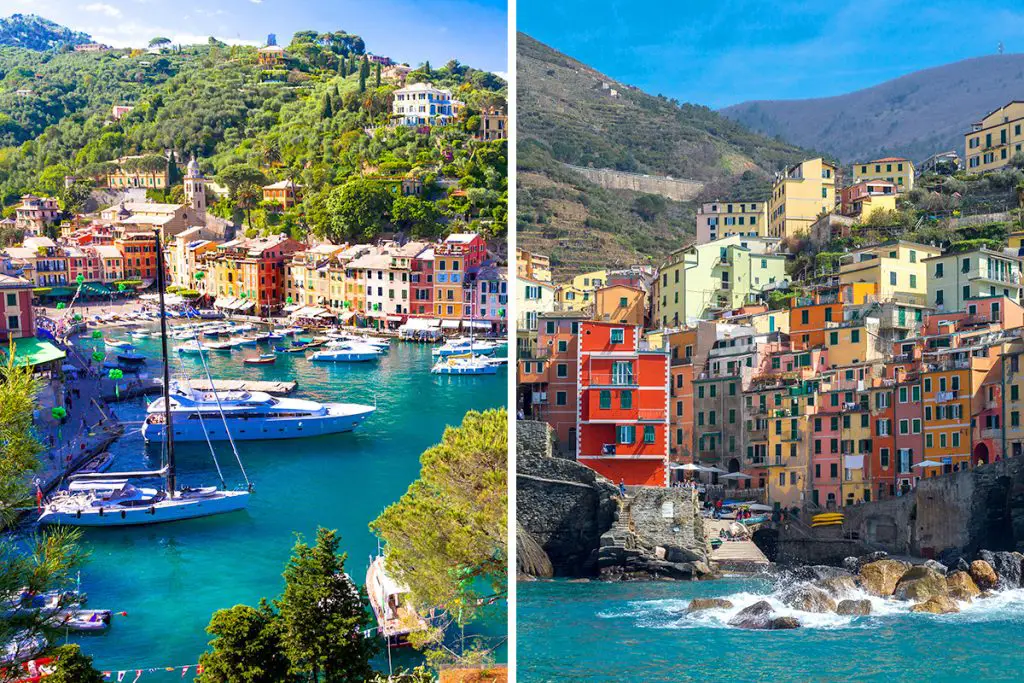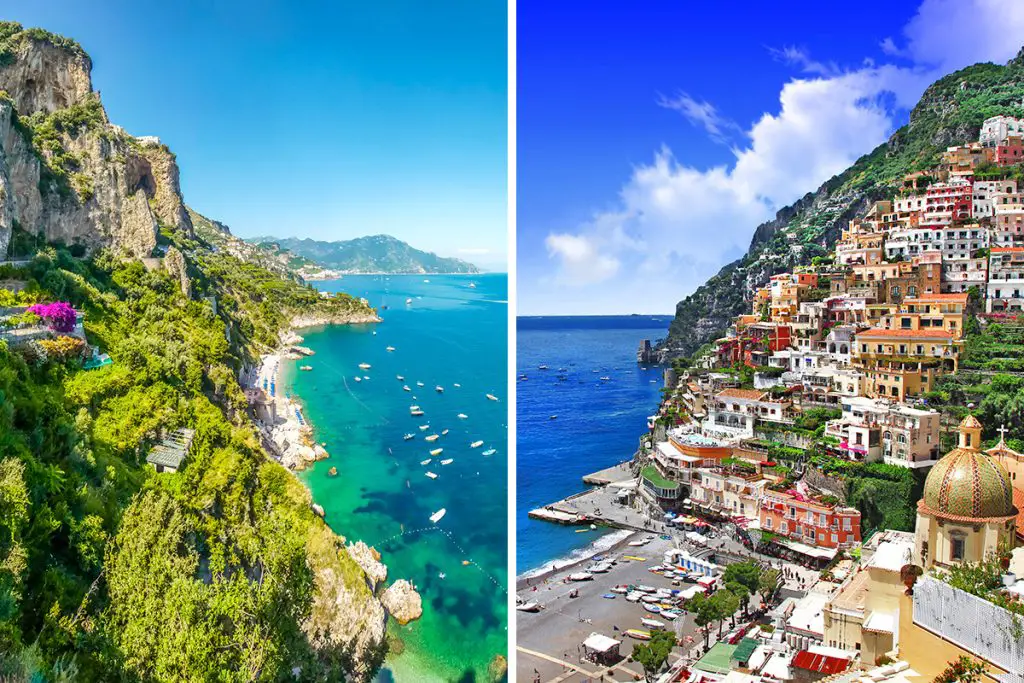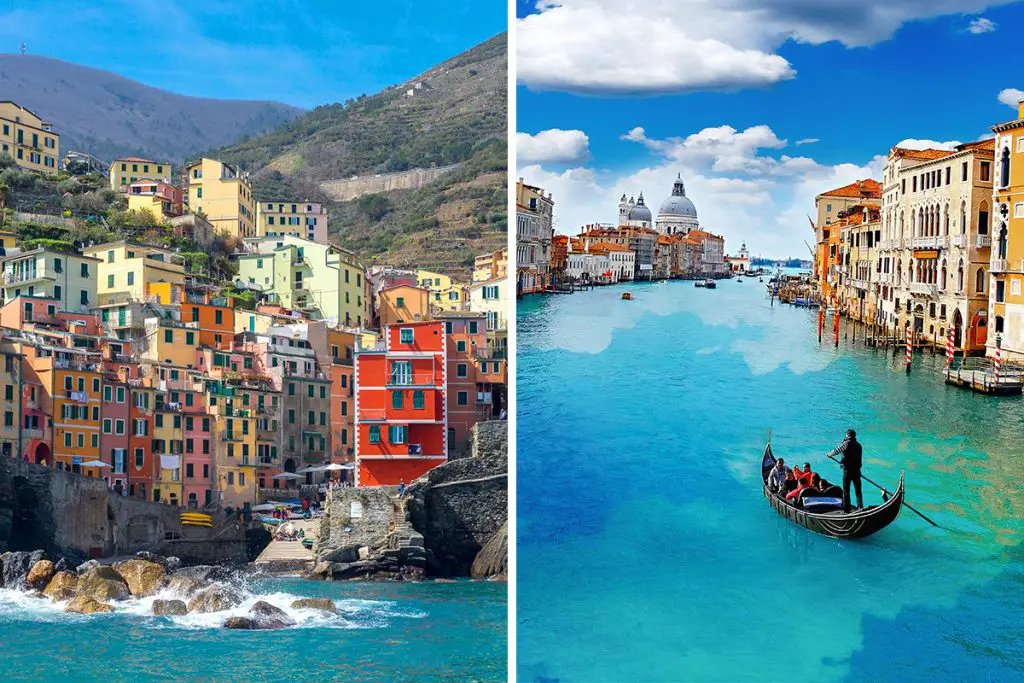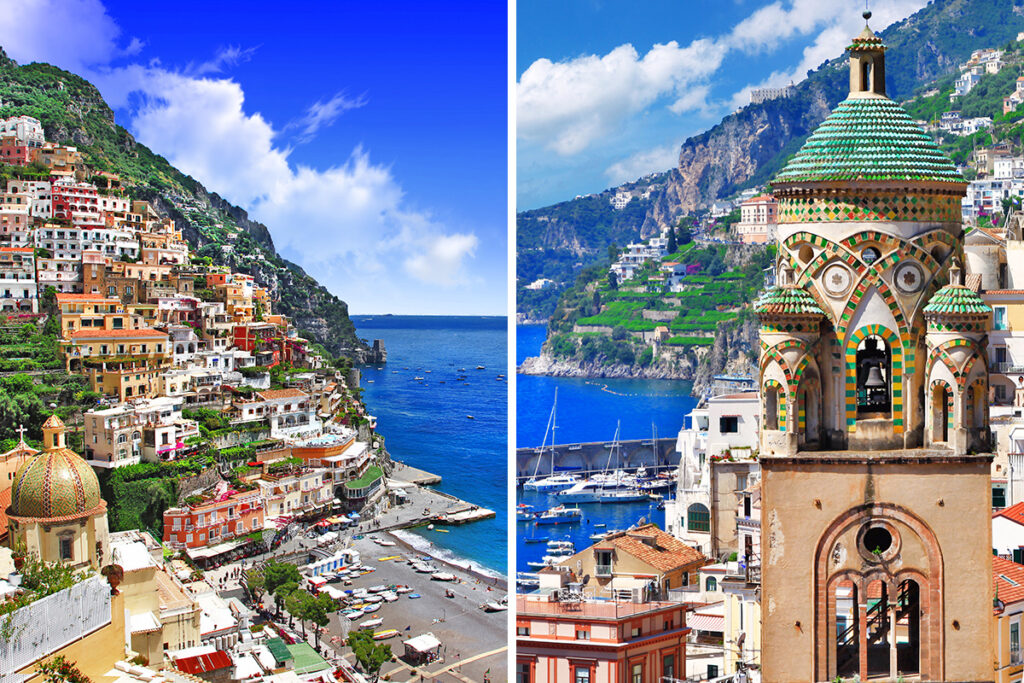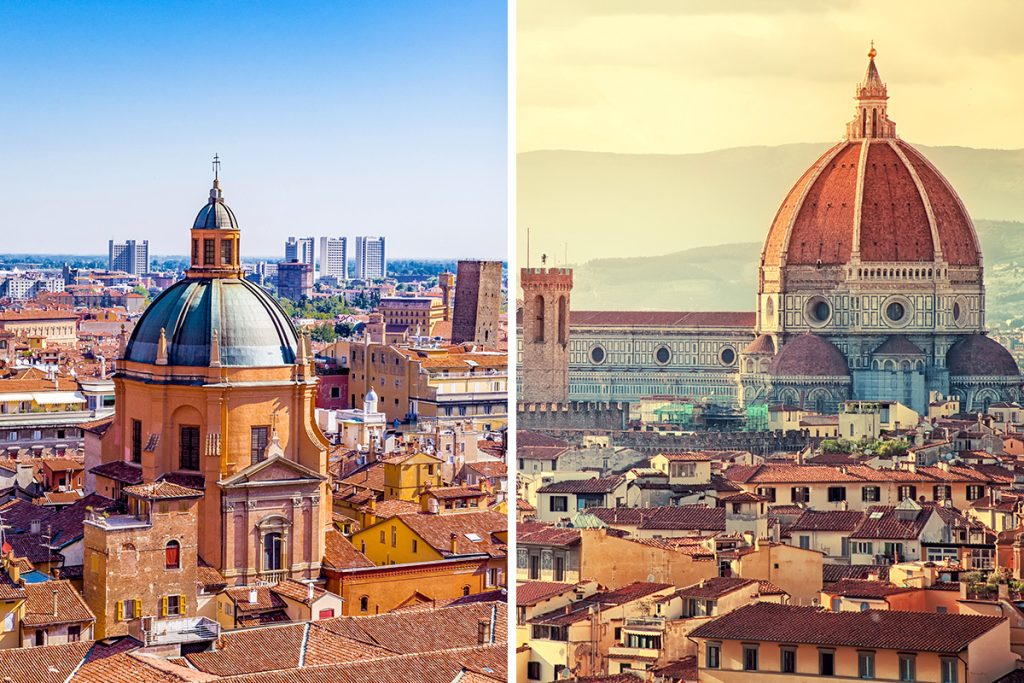In this article, we’ll dive into the details of these two fascinating destinations. Discover what sets them apart and makes them both worth visiting, whether it’s the culture, food, or beaches.
So, are you ready to explore Sardinia and Sicily? Let’s get started!
History & Culture
Both Sardinia and Sicily boast a rich and diverse history, with numerous civilizations leaving their mark on the islands. Let’s delve into the unique historical and cultural aspects of these two Mediterranean gems.
Sardinia, the second-largest island in the Mediterranean, has a distinct culture that sets it apart from mainland Italy.
Its history spans thousands of years, with the Nuragic civilization leaving behind mysterious stone towers, called nuraghi, scattered throughout the island. Over time, Sardinia was invaded and influenced by Phoenicians, Romans, Vandals, Byzantines, and more, all contributing to the island’s unique identity. Today, you can still find traces of these ancient civilizations in the island’s languages, customs, and traditions.
Sicily, on the other hand, has been a cultural melting pot for millennia. As the largest island in the Mediterranean, it has attracted numerous conquerors, including Greeks, Romans, Byzantines, Arabs, Normans, and Spanish, among others. This diverse range of influences has resulted in a complex and fascinating blend of cultures.
Sicily’s history is not only visible in its architectural treasures, like the stunning Greek temples and Roman mosaics, but also in its vibrant traditions, such as the famous puppet theater known as “Opera dei Pupi.”
When it comes to history and culture, both Sardinia and Sicily have their unique appeal. Sardinia’s ancient Nuragic civilization and its more isolated nature offer a different experience from Sicily’s multicultural richness. No matter which island you choose, you’ll be immersed in the captivating stories and customs of the Mediterranean’s past.
In summary, both Sardinia and Sicily offer a wealth of historical and cultural experiences that are sure to delight travelers. While Sardinia has a more distinct identity, thanks to its unique past and relative isolation, Sicily is a treasure trove of diverse influences that have created a rich and fascinating cultural tapestry. Whichever island you choose to visit, you’ll undoubtedly be enchanted by its captivating heritage.
Attractions and Activities
When it comes to attractions and activities, both Sardinia and Sicily have plenty to offer. Each island boasts an array of unique experiences that cater to different interests, from historical sites to outdoor adventures. Let’s compare what you can expect to find on each island.
In Sardinia, history buffs will be thrilled to explore the ancient nuraghi, the mysterious stone towers scattered across the island. One of the most famous is Su Nuraxi in Barumini, a UNESCO World Heritage site. You can also visit the ancient Roman city of Nora, with its stunning mosaics and well-preserved ruins.
If you’re an outdoor enthusiast, Sardinia offers exceptional hiking opportunities, such as the challenging Selvaggio Blu trek along the east coast or the more accessible Gorropu Gorge.
For a more leisurely experience, take a scenic train ride on the Trenino Verde, which winds through the heart of Sardinia’s stunning landscapes.
Sicily, on the other hand, offers a wealth of historical sites reflecting its diverse past. The Valley of the Temples in Agrigento, a UNESCO World Heritage site, is home to some of the best-preserved Greek temples outside of Greece. You can also explore the Roman Villa del Casale in Piazza Armerina, boasting exceptional mosaics that depict scenes from daily life in ancient Rome.
For those looking for an adrenaline rush, try hiking the volcanic Mount Etna, Europe’s highest and most active volcano. Alternatively, take a guided tour of the ancient catacombs in Syracuse or Palermo, where you can discover the early Christian and Jewish burial sites.
If you’re interested in exploring the local arts, both islands have a lot to offer. In Sardinia, you can attend traditional Sardinian music and dance performances or visit local artisans’ workshops to learn about their crafts. Sicily, with its vibrant arts scene, hosts various festivals throughout the year, such as the Taormina Film Festival or the Palermo International Puppet Theatre Festival.
In conclusion, both Sardinia and Sicily offer an array of attractions and activities that cater to a wide range of interests. While Sardinia’s unique nuraghi and outdoor adventures set it apart, Sicily’s diverse historical sites and vibrant arts scene make it equally appealing. No matter which island you choose, you’ll be treated to a memorable experience filled with unforgettable sights and activities.
Beaches
The Mediterranean is known for its stunning beaches, and both Sardinia and Sicily offer an abundance of picturesque shorelines perfect for sunbathing, swimming, and water sports. Let’s explore the unique characteristics of each island’s beaches to help you decide which destination is right for your seaside getaway.
Sardinia is home to some of the most pristine beaches in the Mediterranean, with crystal-clear turquoise waters and fine white sand. One of the island’s most famous beaches is La Pelosa in Stintino, located in the northwestern corner of Sardinia. This beach is renowned for its calm, shallow waters, making it ideal for families with young children.
On the east coast, you’ll find the breathtaking beaches of Cala Gonone and Cala Goloritzé, which offer a more secluded and wild atmosphere, perfect for those seeking tranquility and unspoiled nature.
Sicily, meanwhile, boasts a diverse range of beaches, from sandy stretches to rocky coves. One of the most popular beaches on the island is Mondello, near the capital city of Palermo. This expansive, sandy beach offers numerous amenities, including beach clubs, bars, and restaurants.
If you’re looking for a more off-the-beaten-path experience, head to the stunning Scala dei Turchi on the southern coast, with its unique white limestone cliffs and turquoise waters. The Aeolian Islands, located off the northeastern coast of Sicily, also offer a variety of beaches and hidden coves, perfect for a more secluded beach escape.
In summary, both Sardinia and Sicily are blessed with an abundance of beautiful beaches, each with its unique charm. While Sardinia’s pristine shorelines and crystal-clear waters may be more appealing to some, Sicily’s diverse range of beach landscapes and nearby attractions offer an equally enticing experience. Whichever island you choose, you’re sure to find the perfect beach to suit your preferences.
Eating, Drinking & Nightlife
The Mediterranean is famous for its delicious cuisine, and both Sardinia and Sicily offer a wealth of gastronomic experiences, from traditional dishes to vibrant nightlife. Let’s compare the culinary delights and evening entertainment options that each island has to offer.
Sardinia’s cuisine is characterized by its use of locally sourced ingredients and traditional cooking methods. Expect to find dishes featuring fresh seafood, such as bottarga (cured fish roe) and fregola con arselle (a type of pasta with clams), as well as hearty meat dishes like porceddu (roast suckling pig). For dessert, try seadas, a sweet cheese-filled pastry drizzled with honey.
When it comes to nightlife, the island’s main hotspots are in the Costa Smeralda area, where you’ll find upscale bars and clubs. Alternatively, head to the cities of Cagliari and Alghero for a more laid-back atmosphere, with a mix of bars, pubs, and live music venues.
Sicily, on the other hand, is famous for its diverse culinary influences, which reflect the island’s rich history. Sample classic Sicilian dishes like arancini (rice balls stuffed with various fillings), pasta alla Norma (pasta with eggplant and ricotta), and the ever-popular cannoli, a crispy pastry filled with sweet ricotta cream. When it comes to drinks, don’t miss out on trying the local wines, such as Nero d’Avola or Marsala.
For nightlife, the cities of Palermo, Catania, and Taormina offer a variety of options, from trendy bars and clubs to more traditional taverns and wine bars. During the summer months, many coastal towns also host lively beach parties and outdoor events.
In conclusion, both Sardinia and Sicily provide a unique culinary and nightlife experience that will delight your taste buds and entertain you after the sun goes down. While Sardinia’s traditional dishes and upscale nightlife may appeal to some, Sicily’s diverse cuisine and varied evening entertainment options are sure to please those looking for a taste of the Mediterranean’s rich history and culture.
Whichever island you choose, you’ll undoubtedly enjoy the flavors and atmosphere that make the Mediterranean so captivating.
Shopping
A vacation isn’t complete without a bit of shopping, and both Sardinia and Sicily offer a range of retail experiences, from local markets to luxury boutiques. Let’s compare the shopping options in these two Mediterranean islands to help you decide where to indulge in some retail therapy.
Sardinia is known for its unique, handmade crafts, including textiles, ceramics, and jewelry. For a truly authentic shopping experience, visit local markets like the San Benedetto market in Cagliari or the Alghero market, where you’ll find fresh produce, traditional cheeses, and artisanal products.
If you’re interested in high-end shopping, head to Porto Cervo in the Costa Smeralda area, where you’ll find designer boutiques and exclusive shops. For more mainstream shopping, larger cities like Cagliari and Sassari offer shopping centers and high-street stores.
Sicily, on the other hand, offers a mix of traditional crafts and modern shopping experiences. In cities like Palermo, Catania, and Taormina, you can explore bustling outdoor markets, such as Palermo’s Ballarò or Catania’s La Pescheria, where you’ll find everything from fresh produce to local crafts and antiques. Sicily is also known for its ceramics, which can be found in towns like Caltagirone and Santo Stefano di Camastra.
For those interested in luxury shopping, Taormina is home to designer boutiques and upscale stores, while cities like Palermo and Catania offer a variety of shopping centers and high-street shops.
In conclusion, both Sardinia and Sicily cater to different shopping preferences, with each island offering a unique retail experience. Sardinia’s traditional markets and upscale boutiques provide a contrast to Sicily’s diverse range of shopping options, which include both local crafts and high-end stores. Whichever island you choose, you’re sure to find a shopping experience that suits your tastes and budget.
Accommodation
When planning your vacation to either Sardinia or Sicily, finding the perfect accommodation is essential. Both islands offer a range of options to suit various budgets and preferences. Let’s compare the accommodation choices in these two Mediterranean destinations.
Sardinia has a diverse selection of lodging options, including luxury resorts, boutique hotels, and charming bed and breakfasts. The Costa Smeralda is known for its upscale hotels and exclusive resorts, perfect for those seeking a more luxurious experience. However, if you’re looking for a more budget-friendly option, there are plenty of guesthouses and holiday rentals throughout the island, particularly in the cities of Cagliari, Alghero, and Olbia.
Sicily, on the other hand, offers an equally diverse range of accommodations, from five-star hotels to cozy agriturismo (farm stay) options. In popular tourist destinations like Taormina, Palermo, and Catania, you’ll find a mix of luxury hotels, boutique properties, and budget-friendly hostels. For a more unique experience, consider staying in a traditional Sicilian villa or a charming bed and breakfast in one of the island’s smaller towns.
In summary, both Sardinia and Sicily offer a variety of accommodation options to suit different tastes and budgets. Whether you’re looking for luxury resorts, boutique hotels, or more affordable lodgings, you’re sure to find the perfect place to rest your head in either of these beautiful Mediterranean islands.
Family-Friendliness & Children’s Activities
Planning a family vacation is all about finding the right balance of activities and attractions that cater to both adults and children. Both Sardinia and Sicily offer a range of family-friendly options, ensuring a memorable and enjoyable experience for all ages. Let’s compare the family-friendliness and children’s activities available in these two Mediterranean destinations.
Sardinia is an excellent choice for families, thanks to its beautiful beaches with shallow waters, such as La Pelosa in Stintino or Cala Brandinchi in San Teodoro, which are perfect for young children to swim and play. The island also offers a variety of family-friendly attractions, such as the Sardinian Deer Park in Monte Ortobene or the Diverland water park in Quartu Sant’Elena.
Outdoor activities like horseback riding and guided nature walks are also popular with families, providing a fun and educational experience for kids and adults alike.
Sicily, too, is a fantastic destination for families, with its diverse landscapes and rich history providing ample opportunities for exploration and adventure. The island boasts numerous family-friendly beaches, such as Mondello near Palermo or San Vito Lo Capo on the northwest coast, where children can safely swim and play in the clear waters.
For a more educational experience, visit interactive museums like the Palermo Science Center or the Etnaland theme park near Catania, which features a range of attractions, including a water park, amusement rides, and a prehistoric park. Families can also explore the ancient ruins in the Valley of the Temples or the Roman Villa del Casale, providing an engaging and educational experience for all ages.
In conclusion, both Sardinia and Sicily offer an array of family-friendly attractions and activities that cater to children and adults alike. While Sardinia’s pristine beaches and outdoor adventures create a fun and safe environment for families, Sicily’s diverse landscapes and historical sites provide an equally appealing experience for those seeking a mix of leisure and learning.
Whichever island you choose, you can rest assured that your family vacation will be filled with unforgettable memories and experiences.
Getting There & Getting Around
Traveling to and exploring new destinations is an essential part of any vacation, and understanding the transportation options for Sardinia and Sicily will help you plan your trip more efficiently. Let’s compare the ease of getting to each island and the options for getting around once you’ve arrived.
To reach Sardinia, you can fly into one of its three main airports: Cagliari-Elmas, Olbia Costa Smeralda, or Alghero Fertilia. Several airlines offer direct flights from major European cities, as well as connecting flights from other international destinations. Alternatively, you can take a ferry from mainland Italy or France, with numerous routes available from cities like Genoa, Livorno, or Marseille.
Once on the island, renting a car is the most convenient way to explore, allowing you the freedom to visit remote beaches and attractions. Public transportation options include buses and a limited train network, but be prepared for less frequent service in rural areas.
Sicily is serviced by two main airports: Palermo Falcone-Borsellino and Catania-Fontanarossa, with direct flights from various European cities and connections from other international locations. Ferries also operate from mainland Italy, with routes from Naples, Genoa, and Civitavecchia.
Similar to Sardinia, renting a car is the best way to explore the island at your own pace, giving you the flexibility to discover hidden gems and off-the-beaten-path attractions.
Sicily has a more extensive train network than Sardinia, operated by Trenitalia, which connects major cities and towns. Buses are also available for intercity travel, but schedules can be less reliable in more remote areas.
In summary, both Sardinia and Sicily are easily accessible by air and sea, with multiple options for getting to each island. Once you’ve arrived, renting a car is the most convenient way to explore and make the most of your vacation. However, public transportation options are available for those who prefer not to drive, though they may be less reliable and more time-consuming, especially in rural areas.
Whichever island you choose, plan your transportation carefully to ensure a smooth and enjoyable travel experience.
Weather
The weather can greatly impact your vacation experience, so understanding the climate differences between Sardinia and Sicily is essential for planning your trip. Let’s compare the weather in these two Mediterranean islands to help you decide when and where to go.
Sardinia enjoys a Mediterranean climate, with hot, dry summers and mild, wet winters.
Summer temperatures typically range from 75°F to 90°F (24°C to 32°C), making it an ideal time to visit the island’s beautiful beaches. Spring and autumn are also pleasant, with temperatures ranging from 60°F to 75°F (16°C to 24°C), offering a more comfortable climate for outdoor activities and sightseeing.
Winter temperatures are generally mild, ranging from 50°F to 60°F (10°C to 16°C), but can be quite wet, particularly in the coastal areas.
Sicily, on the other hand, also features a Mediterranean climate but tends to be slightly warmer and drier than Sardinia.
Summers are hot, with temperatures ranging from 80°F to 95°F (27°C to 35°C), making it perfect for beachgoers and sun-seekers. Spring and autumn offer more moderate temperatures, between 65°F and 80°F (18°C to 27°C), ideal for exploring the island’s diverse landscapes and historical sites.
Winters in Sicily are generally mild, with temperatures between 55°F and 65°F (13°C to 18°C), and can be wetter in the coastal regions.
In conclusion, both Sardinia and Sicily offer a pleasant Mediterranean climate, with hot summers and mild winters. While Sicily is slightly warmer and drier overall, both islands provide an enjoyable climate for beach vacations, outdoor activities, and sightseeing.
Safety
When planning a vacation, safety is a crucial factor to consider. Both Sardinia and Sicily are popular Mediterranean destinations, and understanding the safety aspects of each island can help you enjoy a worry-free trip. Let’s compare the safety of Sardinia and Sicily.
Sardinia is generally considered a safe destination for tourists, with low crime rates and a relaxed atmosphere. Like anywhere, it’s essential to take basic precautions, such as keeping an eye on your belongings and avoiding poorly lit areas at night. However, overall, Sardinia offers a secure environment for travelers to explore and enjoy.
Sicily, too, is a relatively safe destination, with most tourists experiencing trouble-free visits. As with Sardinia, it’s essential to practice common sense and be aware of your surroundings, particularly in crowded areas where pickpocketing can occur. Generally, though, Sicily provides a safe and welcoming atmosphere for visitors.
In conclusion, both Sardinia and Sicily are generally safe destinations for travelers. As long as you take the usual precautions and stay aware of your surroundings, you can enjoy a secure and enjoyable vacation on either island.
Cost
Budget is often a significant factor when planning a vacation, so it’s essential to understand the cost differences between Sardinia and Sicily. Let’s compare the expenses you can expect to encounter in these two Mediterranean destinations.
Sardinia is generally considered a more expensive destination compared to Sicily. Accommodation costs tend to be higher, particularly in the upscale Costa Smeralda area. However, you can still find budget-friendly options in less touristy areas. A mid-range hotel in Sardinia can cost around €100 to €150 (approximately $110 to $165) per night.
Dining out in Sardinia can also be pricey, with a meal at a mid-range restaurant costing about €30 to €50 (approximately $33 to $55) per person.
Sicily, on the other hand, offers a more affordable travel experience. Accommodation costs are generally lower, with mid-range hotels averaging between €60 to €100 (approximately $66 to $110) per night.
When it comes to dining out, you can expect to pay around €20 to €40 (approximately $22 to $44) per person for a meal at a mid-range restaurant. Activities and attractions in Sicily also tend to be more budget-friendly than in Sardinia.
In summary, while Sardinia is known for its higher prices, particularly in popular tourist areas, Sicily offers a more budget-friendly experience for travelers. Regardless of which island you choose, it’s essential to plan and research your accommodations, activities, and dining options to ensure you make the most of your vacation budget.
Which Is Better – Sardinia or Sicily?
Choosing between Sardinia and Sicily for your Mediterranean vacation can be a challenging decision, as both islands offer unique experiences and charm. Let’s recap their differences and similarities to help you make the best choice for your trip.
In terms of history and culture, both islands boast rich pasts and fascinating traditions. Sardinia has a unique identity shaped by various civilizations, while Sicily presents an alluring mix of influences from its diverse conquerors. For attractions and activities, Sardinia offers stunning natural beauty, ancient sites, and outdoor pursuits, whereas Sicily provides a blend of historical sites, diverse landscapes, and cultural experiences.
When it comes to beaches, both islands feature beautiful coastlines with crystal-clear waters. Sardinia is known for its idyllic white-sand beaches, while Sicily boasts a mix of sandy shores and dramatic rocky coastlines.
For eating, drinking, and nightlife, both islands offer delicious cuisine, vibrant nightlife, and local wine, with Sardinia leaning towards a more upscale experience and Sicily presenting a more authentic, down-to-earth atmosphere.
Shopping in Sardinia and Sicily varies, with Sardinia offering high-end boutiques in popular tourist areas and Sicily providing more traditional markets and local artisan shops. Accommodation options in both destinations range from luxury resorts to budget-friendly stays, with Sardinia generally being more expensive.
Family-friendliness and children’s activities are abundant on both islands, ensuring fun and memorable experiences for travelers of all ages.
In terms of getting there and getting around, both islands are easily accessible by air and sea, with multiple transportation options available. Renting a car is the most convenient way to explore either island, while public transportation options exist for those who prefer not to drive.
When comparing the weather, both Sardinia and Sicily offer pleasant Mediterranean climates, with Sicily being slightly warmer and drier overall. Safety-wise, both destinations are generally safe for travelers, as long as basic precautions are taken. Lastly, in terms of cost, Sardinia is typically more expensive than Sicily, but both islands can cater to various budgets.
In conclusion, choosing between Sardinia and Sicily ultimately depends on your preferences and priorities.
If you’re looking for a more luxurious experience, pristine white-sand beaches, and unique local culture, Sardinia may be the perfect choice. On the other hand, if you’re seeking a more budget-friendly vacation with diverse historical and cultural attractions, a mix of beach styles, and a vibrant local atmosphere, Sicily could be the ideal destination for you.
Whichever island you decide to visit, you’re sure to create unforgettable memories in these enchanting Mediterranean paradises.


